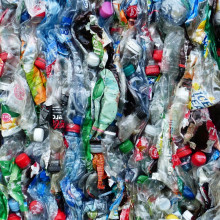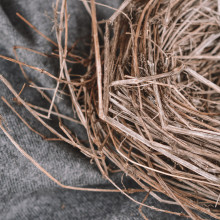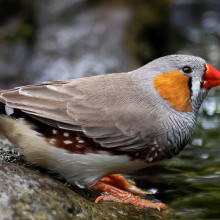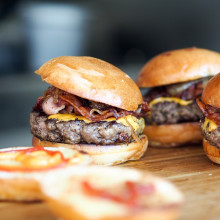This week we’re tuning in to the science of birdsong, including parents who talk to their eggs to warn them of high temperatures, and how traffic noise means young birds are taking longer to learn their songs. Plus, in the news, scientists grow beating hearts in a laboratory culture dish; why the plastic you recycle isn’t going where you think it is; and why a long working week might be the death of you.
In this episode

00:60 - Lab grown mini hearts that beat
Lab grown mini hearts that beat
Sasha Mendjan, Institute of Molecular Biotechnology of the Austrian Academy of Sciences
In a world first, scientists at Vienna's Institute of Molecular Biotechnology have managed to grow miniature hearts from stem cells in a laboratory culture dish. The key, according to Sasha Mendjan who led the work, is adding the right growth signals at the right time. This results in clusters of stem cells organising themselves into a hollow chamber with an inner and outer lining, and heart muscle cells that beat. It's early days, but this will enable researchers to study the basis of some common heart diseases, and ultimately takes us a step closer to growing a new heart from scratch, as Sasha explained to Chris Smith…
Sasha - What we are looking at is essentially a chamber-like structure, or heart 'left' chamber. And we essentially managed to recapitulate its development - how it develops from a stem cell-like state - which we find also in the human embryo.
Chris - You mentioned the embryo - the heart's actually one of the first organs to form, isn't it?
Sasha - Yes. It's the first organ to form; it already starts beating on day 23 of human development, which is a stage of development where we cannot even look at really in detail. This is when we know that congenital heart defects arise, and they are quite common - about 2% of all children that are born have one. But what is even more important is that these developmental mechanisms are also very important later on for disease, for example for regeneration or their response to injury, how our heart grows, and also how our heart fails. All these developmental mechanisms are involved.
Chris - You've done this from stem cells. People have used stem cells to build cardiac, and also blood vessel tissue, in dishes before to do this sort of thing. So what's different with what you've achieved?
Sasha - The difference is that we managed to figure out how we can add specific molecules to the media where these stem cells grow and tell them how to build a heart by themselves. This is how our organs develop. And this is what now, for the first time, we've managed to do with the human heart. What people previously managed to do is to instruct the cells, the stem cells, how to form different cell types that we find in the heart like the muscle cells or the cells of the vasculature. But what they didn't figure out is how to form the whole structure.
Chris - Can you talk me through, then, the entire sequence of experiments - what you do, with what, in order to make this happen?
Sasha - We put our stem cells into a plate that has 96 wells. And then in each well, one of these cardioids - as we call them - starts developing as we give the cells the instructions. Essentially we are giving them molecules at very specific times during a time course of about seven days. And these molecules tell the cells, "okay, I need to build a chamber that is beating, that has an inner lining as a real heart would have, and also an outer layer as a real heart would have." And this is what we achieved.
Chris - And the molecules that you put in - they're sort of growth factors or chemical cues that are the nudges that tell the cells, "now do this, now do this"?
Sasha - Exactly. They are proteins that will bind certain receptors on the cells and will signal. We call them signalling molecules. And this is exactly what we do.
Chris - And when you look at these mini chambers - these cardioids, as you're dubbing them - down a microscope, do they look like... if you were to take a piece of heart out of a developing embryo, it would really look like that?
Sasha - Yeah! This was exactly the amazing thing. The first time we saw it I just couldn't believe it, because this is exactly how an embryo in a heart would look like. It's hollow, it's this beating chamber. It was quite amazing to look at together with the students.
Chris - Now you know how to do this, what can you do with it? What are the applications?
Sasha - The main application - we could recapitulate a genetic defect of the heart where the development of the chamber is impaired. This is related to the probably most severe genetic defect you can have actually in children that affects the heart, which we call hypoplastic left heart syndrome. And there, basically the whole left ventricular chamber of the heart gets obliterated, and these kids need surgery within a week otherwise they will die. And now, really for the first time, we can start looking into the mechanism of that particular congenital defect.
Chris - Would you do that by taking stem cells from children who have that disorder, or a family history of that disorder, and using their stem cells - so the heart, the cardioid, that develops in your system, essentially looks like a mini version of what happens in reality?
Sasha - Exactly. So this is what our next step is going to be now. We are going to take cells from these patients, reprogramme them into the stem cell state, and then we're going to try to re-enact, recapitulate the disease, what happened, what went wrong in these kids. And then that of course means that maybe we can also try to find a way to either predict this or figure out why is this happening, etc. Because as I said, cardiac defects are much more common than other defects and we don't really know why.

06:31 - UK 'recycled' plastic found dumped in Turkey
UK 'recycled' plastic found dumped in Turkey
Sam Chetan-Welsh, Greenpeace
We’ve remarked many times on this programme that the world is producing a lot of plastic waste. Millions of tonnes of it per year. And if you look at “plastic per person”, the UK is a major culprit. Now you might think - that’s OK - because we have recycling in the UK for plastic cartons and bottles! But - a new report from the charity Greenpeace says that’s not solving the problem - because a lot of it is being sent abroad. The report claims that well over half the plastic we think gets recycled is exported to countries like Turkey, where it mostly just gets dumped. When investigators travelled to Turkey, the scenes they discovered were truly shocking. Phil Sansom spoke to Greenpeace’s Sam Chetan-Welsh...
Sam - What we found is widespread and extensive evidence of UK supermarket plastic being dumped and burned in southwest Turkey. Tesco cheese packets, yoghurt pots... we found piles of it on fire, causing breathing problems for people in the local area; we found the rubbish leaking into watercourses, into streams, into rivers, and that will eventually make its way onto beaches and into the Mediterranean.
Phil - This is really shocking! How on earth is rubbish from UK supermarkets ending up by the side of the road, burning, in Turkey?
Sam - It's a complicated story. And I would give a big caveat that this is a very complicated system, it's very opaque, there's a lot of crime and illegality. The best that we as Greenpeace can surmise about what's happening is: say you've got your milk carton or your yoghurt pot. You wash it, you put it in the recycling. What happens then is it goes to a Materials Recovery Facility, and that's where it gets sorted into waste that's clean enough to actually be mechanically recycled again, or it gets baled up with what's called mixed plastic waste. What we found is that a lot of the clean stuff is going into big containers to be exported, and then mixed up with all of those mixed bales of plastic waste. And then it gets sent off to countries like Turkey.
Phil - Are UK companies paying the people to transport it to Turkey? Or they selling the waste so that the people in Turkey can get the good stuff out, and maybe make a buck off that?
Sam - There are layers of different people paying different types of money. The supermarkets, for example - they do pay, because they buy these certificates to kind of confirm, "hey, I'm Tesco, I'm Coke, I've made this much plastic this year so I need to pay for this amount to have it recycled." The issue with that is - there's no checks on the Turkish side, so it's a lot cheaper for companies through this chain to pay for it to be exported. At the Turkish side, for example, it will be bought by a company who can then make money off extracting the valuable material from these mixed, contaminated bales, and then essentially - on the hush hush - dumping all the rest of it.
Phil - Is that how this is going wrong, then - that people on the UK side are just abandoning their responsibility by giving away the plastic and saying, "all right, I'm sure you're going to recycle it." And the people who take it go, "sure thing, yeah, I'll do that," and then just do whatever they want.
Sam - Yeah. There's widespread fraud and corruption within the system, which is a big problem. But really Greenpeace's diagnosis is that at the heart, even if you improved enforcement and monitoring, you'd never really be able to fix the problem because there's just too much stuff. There's just too many containers. Too much of it is non-recyclable. No-one's got a plan to reduce the amount of waste that we produce in the first place, and that is how you stop this problem. We always think of it like - imagine a bathtub. If your bathtub was overflowing, you wouldn't grab a mop and bucket, you would turn the tap off. And that's what we need to do with the waste system - deal with the waste that's arising at the beginning of this process. That's the only way you're ever going to fix it.
Phil - Right, but how big is the problem? Is this just a small issue that's only part of the plastic that I'll put in my recycling bin, or is it the majority?
Sam - The UK exports two and a half Olympic-sized swimming pools of plastic waste every single day. That is not a small problem; that is something that we need to take responsibility for. Greenpeace estimates only 10% of all UK household plastic packaging actually gets recycled here in the UK. But look - ultimately, in our view, a kilogram of exports being dumped on another country, on a poorer country, on communities of colour to deal with, leaking into their watercourses, causing breathing problems in their local communities, is completely unacceptable - never mind two and a half Olympic-sized swimming pools of plastic every single day. This is something we need to take responsibility for. Government has been relying on this as part of their waste policy for such a long time. Plastic waste exports have increased by sixfold since 2002. And what we're saying is: stop dumping our waste on other countries, stop relying on this to deal with waste that we should be cleaning up ourselves, firstly by reducing the amount of plastic that we make and use here in the UK.
Phil - I mean, what am I to do as just someone who tries to recycle? Is this plastic recycling system broken?
Sam - What I really don't want people to take away from this is that they should stop recycling, that they should give up, that they should be cynical about the system, that they shouldn't keep doing their bit - because that habit is going to be crucial for us in the future, the habit of washing stuff and doing the right thing. But recycling on its own is never going to be able to solve this problem. We are simply making and using far too much stuff.

13:26 - Bird species losing ground in Ethiopia
Bird species losing ground in Ethiopia
Andrew Bladon, University of Cambridge
Climate change poses a serious threat to thousands, if not millions, of species around the planet. But two - the White-tailed Swallow and Ethiopian Bush-crow, are particularly at risk. Scientists are predicting that both of these birds will suffer an extreme loss of their native habitats, even under the most optimistic global warming scenarios. Cambridge University’s Andrew Bladon has been leading this study, and spoke with Chris Smith...
Andrew Bladon - These two species are really interesting because they have incredibly small global ranges. Both of them are only found in a tiny area of Southern Ethiopia. And the interesting thing is that both species, the area in which they are found is cooler and drier than surrounding areas. And this seems to be the determining factor in limiting the distribution.
Chris Smith - And how did you realize that there was this threat?
Andrew Bladon - For a long time, scientists were puzzled as to what was going on with these species. So when they were first described, people sort of talked about the fact that the habitat inside and outside of their range all looked the same, and there was no obvious reason why they would be found in only one location. And then we started a project a few years ago now, looking into this and looked at how temperature impacts the behavior of the birds. So we looked at the foraging behavior of the Ethiopian Bushcrow and found that when temperatures get too high, they really struggled to forage. They don't get enough food. And for the White-tailed Swallow, it appears that there's some impact on their breeding success. So when it gets warmer, they struggle to breed in the nest, start to fail. And so this begins to suggest that when you get to the edge of their distribution in areas where it's generally a bit warmer, they struggled to survive, and that's why they're not there. And then we underpin that with some big distribution models where we compared climate in the areas where they are found and the areas where they're not found and found that indeed the areas where they're not found are warmer and a bit wetter than the areas where they are.
Chris Smith - Can you use models like that then to look at ways or explore ways in which you might be able to reverse some of the threats or, find alternative places for them to live?
Andrew Bladon - Yeah, so one thing that these models allow us to do is to look at the areas that are likely to remain the most suitable. So we can project these models into the future under different climate scenarios and see how the climate is likely to change and which areas are going to remain the most suitable for the species. And those areas are probably the places that we want to target for conservation, i.e. for protection of the habitat, perhaps for habitat improvement and mitigation strategies to try and create the sort of optimal habitat that maybe provides cooler environments for the species. But the problem is that we're talking about such a small area and such a rapid rate of change that actually the suitable climate is probably just going to disappear too quickly. So the other kind of option is to then start looking at where else in the world might the climate be suitable? And can we introduce them into a different habitat, but that comes with its own sort of set of risks and it's quite controversial.
Chris Smith - Presumably these animals are just the canaries in the coal mine in many respects, aren't they? There must be thousands to millions of species, similarly, imperiled by climate change with very, very rigid constraints on where they can exist. And it's just going to be an impossibility for us to find new homes, and then rehome quite that many species.
Andrew Bladon - Yeah. So the real advantage of these two species is because their range is so small, and appears to be entirely predicted by these climate factors. It's very easy for us to build these models and sort of say, well, this is what's driving their distribution. For a lot of species, they will be similarly threatened by climate change. But if they have wider distributions, that might be an area where they're sort of actually limited by unsuitable habitat and an area where they're actually limited by some competition with other species. And so it makes it harder for us to predict what's going on. So one option that we have with these spaces is by actually monitoring the rate at which they decline in the coming years, we can try and validate the models that we've built. And that could be really important because these models are really commonly used for predicting what's going to happen to species in the future.
Andrew Bladon - But we don't actually have very good data on how well they produce those predictions. And so if we can use data from the Swallow and the Bushcrow to validate these models and validate the predictions that they make over the next 20 or 30 years, we might be able to apply that to other species where we're working with a slightly wider time window. So for these two species, we're looking at the potential disappearance of their entire distribution within the next 40 or 50 years. Whereas for other species where we might be talking about 80 or a hundred years, we've got a bit more time to think, well, if we can validate these models, we know that they're accurate and then we can work with what they're telling us to try and better conserve other species,
Chris Smith - A silver lining to what is though, a very, very dark cloud.
Andrew Bladon - Yes, indeed. It's quite sobering to work on two species for sort of six or seven years. And then to realize that the end result of this is actually, they're probably both going to go extinct and there's very little we can do about it.

18:36 - Long working hours increase risk of death
Long working hours increase risk of death
Frank Pega, World Health Organisation
The COVID pandemic has brought into sharp relief the toll working long hours takes on your mental and physical well being. Now, scientists at the WHO have managed to put numbers to the problem - by combining data from a global, 10 million person survey with reports from countries around the world about causes of death, they’ve calculated that 745000 people died in 2016 due to stroke or heart disease caused by working longer hours. Lead author on the study Frank Pega from the World Health Organisation spoke with Eva Higginbotham...
Frank Pega - Forty professors from around the world looked at a number of different categories of long working hours. And when they crunched the numbers and looked at all the available evidence, they found that there was strong evidence that when people work 55 hours or more per week their risk for chronic heart disease and stroke is increased. And indeed that's very common in health science. And we talk about a risk limit here.
Eva Higginbotham - What's the mechanism, or what's the link between working long hours and having a stroke or having heart disease.
Frank Pega - The first link is in a way, a direct pathway where people who work long hours and all of us who have worked long hours or know somebody who's worked long hours has experienced this, basically feels stressed. Our body has a physiological physical response to working long hours. It releases stress hormones, and these stress hormones directly damage the heart or the brain and thereby they can directly produce heart disease or stroke. A second pathway through which long working hours can cause these diseases is by them increasing other risk factors for heart disease and stroke. So for example, people who work long hours may as a result also be more likely to smoke or to drink alcohol or have sleep deprivation. This in turn could then cause heart disease or a stroke event.
Eva Higginbotham - Is this true for all kinds of jobs or just for jobs that we might traditionally think are very stressful? I'm thinking things like manual labour or people who are like CEOs, running big companies who are under high stress and work long hours?
Frank Pega - We've done some analysis to look at the available data that is broken down by occupations and by industrial sectors. This is how we divide the world. And we found that everybody who works long hours seems to be at the same level of increased risk in as far as the evidence is currently available.
Eva Higginbotham - I'm wondering if there's an age factor here because people will sometimes say, you know, work hard in your twenties, your thirties, your forties, and then you'll be able to relax when you're older. Do we know if working long hours at any stage in your life is damaging or is it just later or just earlier?
Frank Pega - We did not see differences in risk across age groups. In other words, if you're working long hours when you're 20, or if you're working long hours when you're 60, makes very little difference for your actual increase in risk of having a cardiovascular disease or stroke event. However, what we do notice when it comes now again to the number of people dying of cardiovascular disease, so heart disease, stroke, is concentrated specifically amongst middle aged and older people. So when we ran our estimates and we did our modelling, we found not surprisingly that more people died from long working hours in these middle aged and older working age groups than younger people did, but to be clear the risk's the same.
Eva Higginbotham - And is this a global problem? Did you find that there were some places that had a higher resulting risk from longer hours versus others?
Frank Pega - So what we found is that when we looked at the distribution of the number of deaths, for example, from these two conditions, from stroke and heart disease, that these were particularly high in two regions in the Western Pacific region, and in Southeast Asia. There were other regions where the numbers were much lower, for example, in Europe and also in North America. So there's clearly a geographic patterning.
Eva Higginbotham - Is that because there are more people in those regions who work those hours or the type of work that they're doing, or other factors in their lifestyle, do we know?
Frank Pega - One part of the puzzle and one part of this explanation is that there's definitely a higher proportion of people working long hours in these regions. And if you ask why that is, one reason is that these regions have a number of low and middle income countries, for which we know that a large proportion of the workforce of people working are in an informal economy. So they do not have a formal employment contract. That means often these are workers who are disadvantaged, so they may not have a choice, but work multiple jobs at a time, which of course means clocking more and more hours.
Eva Higginbotham - What can we do to try and stem this problem?
Frank Pega - We recommend four arms of action. First, laws and policies to be put in place by governments, but also employers and workers to limit numbers of hours of work per week to healthy limits. The second area of intervention would be to make sure that working time arrangements are more balanced. For example, workers can be offered working time or can be working on flexi time. The third intervention, and this is very important for workers in the informal economy, so those without formal employment contract, they are not covered by the protections of social security and employment that are normally offered to work as in the formal economy. So here we need to, countries are encouraged to offer social protection floors. These are antipoverty programs which enable these workers to not have to work long hours and multiple jobs in order to survive. Fourth, and finally, we recommend that all workers have access to occupational health services where occupational health physicians can make sure that the numbers of hours worked stay below the unhealthy limits.

27:23 - Birds warn their eggs of warm weather
Birds warn their eggs of warm weather
Mylene Mariette, Deakin University
There are around 5000 different species of songbird around the world and, together, they create a playlist that can rival Sony. But, most songbirds don’t just sing - they will also make calls and coos to communicate. And in recent years it’s come to light that these calls can be very important very early in a bird’s life; in fact, before it’s even hatched in some cases, as Eva Higginbotham has been hearing..
Eva - One evening, recently, I went for a walk in Cambridge, on a small path next to a stream shaded by tall trees covered in leaves, and surrounded by grasses, bushes, and, of course, nettles…And along with the green I could feel under my feet, I could hear what sounded like an incredible array of birds singing and calling to each other, likely male birds, singing to defend their territory and try and seduce the ladies. That’s how we traditionally think about how and why songbirds communicate. But, a few years ago, a scientist studying zebra finches, small somewhat stripey, australian songbirds, discovered something.
Mylene - So they have different sorts of calls, but they mostly talk to each other to sort of coordinate parental care.
Eva - that’s Mylene Mariette from Deakin University, and she was studying how mum and dad zebra finches chat to each other to figure out how long each of their egg-incubation shifts were going to be. This is what that conversation can sound like
BIRDS SWAPPING
Eva- Squeaky! But then, Mylene noticed something unusual…
Mylene - And I also noticed that when a parent is sitting by itself in the nest, it produces a call that is really different to the other calls. And because he was alone with the egg, I wondered whether he was talking to the egg. So it's really fast and really high pitched, which is surprising for this species because it tends to have very nasal calls, but that one, yeah, it's really, really quite high pitched. It sounds like crickets, really.
Eva - Mylene set about trying to understand, first of all, what this unusual call could mean
Mylene - So I did a lot of recordings in the nest and it quickly became apparent that this was only happening when it was hot and because the weather is so variable in Jalong, I could very clearly see a link between that call and the temperature outside. So it's only when the parents were too hot that they were producing that call.
Eva - So, Mylene snuck out the real eggs and replaced them with fake ones. Then, she incubated the eggs she’d stolen and either played back recordings of heat calls, or just the normal parental chatter that the birds made whatever the weather. Just before hatching, she returned the real eggs to the nest to see what would happen.
Mylene - We found that having heard those heat calls before hatching then changed the development of the chicks after hatching. And so the ones that were when exposed to heat call tended to reduce their growth in the heat. Whereas the ones that were exposed to another contact call from the parents tended to get bigger when it was warmer.
Eva - At hatching, the two groups weighed the same, but within 24 hours there was a difference in size, and this just kept getting bigger until, by the end of the nesting period, there was a 25% difference in body weight between the two groups. This opposite growth strategy seemed puzzling at first, but then, being small in hot weather can be advantageous as it allows animals, us included, to dissipate the heat better. Also, growing itself requires quite a lot of energy and so creates quite a bit of heat. Mylene realised that the heat calls were telling the embryos - don’t grow too quickly when you hatch! But how?
Mylene - So we don't know the details yet, but obviously we're really interested in finding out. So looking into neurobiology, there are actually some connections in the brain that go directly from the auditory centre to the centre that controls emotion and hormone production. And we know from adults, for example, that it is those connections that trigger spontaneous response to sound.
Eva - The question was, did this growth difference actually translate into a more successful bird?
Mylene - After they grew up we just let them breed because we wanted to know whether that strategy of reducing the growth in the heat could be beneficial. And we found that the birds that had reduced their growth in the heat were producing more babies. And we also found that those individuals, when they were adults, were preferring hotter nests to breed in, so it does seem to have changed them in the long term.
Eva - And, Mylene realised that the heat call had a benefit for the parents too
Mylene - When the parents are calling, it's actually a special form of panting. So when the birds are too hot, they pant like dogs do. And that's when the heat call is produced.
Eva - Experiments showed that producing the heat call cools the birds more than just their regular panting, and this also provides a potential mechanism for this behaviour to have evolved
Mylene - So parents would produce those calls to cool down in the nest when it's really hot and during a heat wave. And just because of the benefits that it brings to the offspring, then that can be selected for, and it becomes more and more common. And so eventually the parents turn the call into a signal because they also benefit from their offspring being higher quality in hot weather.
Eva - And for the embryos, listening to what’s going on outside plays an important role in hatching too…
Mylene - They all use sound to know when is the best time to hatch so they can synchronise hatching between the embryos in the clutch, or a predator arriving and coming to eat the egg. So sound is used during development a lot more than we thought initially when we started this project. But there have also been some studies in seagulls, where they found that embryos that have been exposed to alarm calls that their parents do when there are predators around also change the development of the chicks. And so it's likely that it's quite common, but we just haven't looked at it basically.
Eva - That zebra finches, and perhaps other birds, do this, might suggest that they are going to be a little more adept at surviving climate change than some other species. Here in Cambridge though, I’m still likely listening to lonely bachelors looking for a mate to start a nest with...

34:18 - How do songbirds learn to sing?
How do songbirds learn to sing?
Mimi Kao, Tufts University
Once birds make it out of the nest, songbirds have to set about learning their songs. Some birds, like parrots, are called “open-ended learners” because they can continue learning more and more sounds over their lifetimes. But others, on the other hand, have only a specific period of teenagerhood where they learn their songs, and zebra finches are an example of this. Mimi Kao, at Tufts University, studies how this happens, and spoke with Chris Smith...
Mimi - Well, vocal learning in songbirds shares many similarities with vocal learning in humans, and it occurs in two phases. In the initial sensory phase of learning, birds are just listening, and they're forming an auditory memory of an adult tutor. And then in a second phase, known as sensory motor learning, they begin to practice. And the sounds that they make first are quite variable, much like the babbling in human infants, but they're listening to themselves as they're singing and they're trying to correct it. And so they continue practicing thousands of times a day until they're able to make an accurate copy of the tutor song.
Chris - Why teenagerhood, why don't they do that from the get-go?
Mimi - Well, initially the areas of the brain that are important for producing songs are not totally wired up. So the connections aren't there yet. The auditory areas are there and functioning, so they're listening, but around 25 or 30 days those connections from the song motor region form the connections with the next region and the birds begin to vocalise.
Chris - Interesting that it's the adolescent period of their life, and we're very familiar with human adolescents, especially if they're male, doing all kinds of extraordinary extravagant things to try to get the attention of the opposite sex. So you've sent us a couple of clips of what happens with the birds you've been studying. First of all, we're going to hear the sound of a male just singing.
Mimi - Well, you'll hear a short clip where the male sings a couple of repetitions of his song. And he knows how to sing it, but sometimes it's a little variable and he might also vary the timing, so there might be some pauses.
Chris - And we're going to contrast that with what happens when you introduce a female into the mix, so the male's aware that there's a female there.
Mimi - Yeah, so we think of this as a high intensity performance song. He sings faster, he sings more of the repeats. It's just a higher song rate.
Chris - But this is like, you know, doing extra flips on your skateboards, trying to get the girls interested.
Mimi - Definitely! The male is trying to get the female's attention and he's singing his best version of song. And even though we can't hear it, the female can hear subtle differences between when the male is practicing and when he's performing. And it turns out that the performance song is much more stereotyped from one trial to the next.
Chris - You mentioned earlier about how the brain wires itself up and then reaches this point at which it's optimally wired in order to start being able to acquire songs and then memorise them. Do we now understand though, which bits of the brain are doing that?
Mimi - There are two or three parts of the brain that are involved in this. Song motor areas that are producing the sound, auditory areas that are used for evaluating the performance of the song, and then there's a cortical basal ganglia circuit that we know is important for learning the song and for being able to change it from moment to moment, but also over the course of learning.
Chris - Are they the same bits of the brain that I'm physically using to talk to you?
Mimi - Yes, there are many similarities. Basal ganglia circuits are found in all vertebrates and they're important for motor learning and for motor performance in all vertebrates. And one thing that makes songbirds special is that, like humans, there are connections from the cortex to those motor neurons that then project to the parts of the body for producing the sound.
Chris - And does that mean if you know which bits of the brain are doing this, you can actually potentially manipulate it and thereby prove that that's how the birds are doing what they're doing?
Mimi - Yes. There've been a number of studies to manipulate either those motor areas that are responsible for producing the song or this cortical basal ganglia circuit that's important for learning and for changing the song.
Chris - And can you therefore physically change how a bird sings? If you were to go in and fiddle with those brain areas, would the song change?
Mimi - Yeah so for example, we can put in certain drugs into the brain to change the level of activity in that part of the brain. And if we do this in the cortical basal ganglia circuit and we activate it, so we cause it to fire more and to send signals at a higher rate, then we can drive changes in the song and cause the bird to change the performance of individual syllables, for example, altering the pitch. We can also change the sequence of the song. And most recently we've shown that we can cause birds to stutter so that they'll repeat certain elements of their song a small number of times before moving on to the next syllable.

39:42 - The evolution of songbirds and vocal learning
The evolution of songbirds and vocal learning
Erich Jarvis, The Rockefeller University
How did birds evolve to sing in the first place? Erich Jarvis from Rockefeller University is an expert in the evolution of birdsong, and he spoke to Chris Smith...
Erich - All birds and even humans and non-human primates and frogs and so forth, all of them have the auditory pathway that Mimi was talking about to perceive sound. Like your dog can understand the word sit. But only the species like us humans and these songbirds have these other brain pathways she was talking about for producing the sounds. And, just like you asked ,that brain pathway, even though it's only in a few groups of animals like us humans and songbirds, it evolved in a very similar way, consisting of a motor pathway to produce the sounds and this forebrain loop that she talked about to actually imitate the sounds you produce.
Chris - Could, therefore, birds that aren't naturally songbirds, be actually taught to sing, then?
Erich - Not, unless they have this forebrain pathway that controls the production to imitate the sounds. You would have, it would have to evolve it or experimentally you would have to induce it.
Chris - So a seagull, for instance, couldn't sing like a zebra finch.
Erich - Right exactly. So a seagull can understand and listen to a zebra finch song or other seagull vocalisations and maybe understand the meaning, but the seagull cannot actually imitate another bird song, unlike the zebra finch, which can.
Chris - Now given that birds evolved from dinosaurs, does that mean then that dinosaurs were vocal in the same sort of way? Were they probably singing like songbirds, some of them?
Erich - Yeah, so the vocal learning birds evolved between 30 and 50 million years ago, but birds go back well beyond a 100, 200 something million years ago. But bird brains and birds themselves are actually dinosaurs. And there's more and more evidence to show that the brain regions that support the vocal learning circuits in birds, and that is the subdivisions in which they are housed, those subdivisions you can find in all birds and in crocodiles and in lizards and in turtles. So I think dinosaurs had the capacity to evolve vocal learning. Whether that happened or not we don't know, but still they did have the capacity in terms of the brain subdivisions.
Chris - Well, they were certainly very musical weren't they, I mean, think about T-Rex. Sorry. Bad joke! But why I wanted to bring up T-Rex was this whole question also, because it's not just about sound, is it, it's all about rhythm as much as anything else. So is there anything special about birds brains that mean they're very good at timing so they can count beats, get the rhythm right?
Erich - Yeah. Good question. So it was shown about 10 years ago actually that only vocal learning species can learn how to dance. And what I mean by that is learn to move their body muscles to a rhythmic beat of music - like one, two, three, four, one, two, three, four to the downbeat for example, on the one. Other animals will respond to human music, but they won't be able to synchronise their body rhythms to the music. And what's going on here, I hypothesise, that once the vocal learning pathway evolved to take sounds that you hear and imitate it through larynx, your vocal organ, what happened is that the hearing information contaminated the rest of the brain and not only is it influencing your vocal organs to produce the sounds, it it influencing your hands, your chest, your legs in a rhythmic fashion that you don't see in the other species that can't imitate.

44:26 - Songbirds affected by human noise pollution
Songbirds affected by human noise pollution
Sue Anne Zollinger, Manchester Metropolitan University
Songbirds have been singing, and learning how to sing, for likely millions of years. But now there’s evidence that in recent years us noisy humans are disrupting the process. Sue Anne Zollinger is from Manchester Metropolitan University and she studies how birdsong is changing. She spoke with Chris Smith about the impacts that humans are having on birds, and on birdsong...
Sue Anne - Well, lots of noise that annoys us as humans is also what's interfering with birds being able to hear, and properly learn like traffic noise, airline noise, and other kinds of industrial noise pollution, that makes it harder for us to communicate also when we're exposed to it.
Chris - How do we know that's going on?
Sue Anne - We know birds do a lot of things differently in noisy places. So if you look at the songs of birds that live in noisy cities, their songs have started to diverge a little bit from what we hear in their traditional habitats, like quiet forests or grasslands. And those kinds of changes depend on the species. So lots of species around the world start to sing in slightly higher pitch in cities, and that's thought to help them avoid the loudest part of that low frequency rumble that you get from road traffic noise. Lots of birds, we know, sing louder, but they're not able to sing as much louder as they need to, to be able to really belt it out over the din of that traffic noise often. And sometimes they also change when they sing. So sometimes in really busy urban areas, birds start to sing earlier in the morning, or later at night to try to avoid those peaks of traffic that you get at rush hour.
Chris - So they're compensating, but it doesn't necessarily solve the problem, every time.
Sue Anne - That's right.
Chris - You've been doing some experiments on this, haven't you and you sent us some clips of this. So let's have a listen to these. The first one that you've got here is the gold standard. And perhaps you could begin by just telling us how you did the experiments and what this gold standard song that we're going to hear is.
Sue Anne - We wanted to look at how the noise would influence development. So during that process Mimi was just talking about where they have to go through this process of listening, learning, and imitating the song that they hear. And so we had half of our birds growing up in a quiet room and half of them in a room filled with traffic noise, like you would experience in the city. And we wanted all the birds to have the same opportunity. So this golden tutor that we're going to listen to is the song that all of the birds heard.
[TUTOR BIRD SONG]
Chris - So the first group of birds you mentioned, had a pristine environment as it were, they were exposed to that song we just heard, they had to learn it. And this is the result I presume, you're going to play for us now, of them learning that song.
Sue Anne - That's right this is the example of a juvenile from that quiet room. What I hope you can listen to in this song is that he doesn't sing exactly the same song, but he copies a lot of those syllables that have the same kind of rich harmonic structure you can hear in the tutor.
[GOOD LEARNER BIRD SONG]
Chris - And now we're going to delve into what happens when you expose them to motorway noise. This is the traffic group. What are we listening for this time?
Sue Anne - This guy, he doesn't copy any of those syllables. So it's a little hard for us to hear as humans, because we don't have the good ability to hear those fine differences. But what I want you to listen for is that none of the acoustic structures are the same. So it sounds a little more rough and click-like. It's kind of harmonically, not as nice.
[BAD LEARNER BIRD SONG]
Chris - So an example of a less good learner caused by exposure to noise pollution. How does that actually affect the birds downstream though, Sue Anne, what objective evidence have we got that it is?
Sue Anne - We know from some field studies that females in urban areas prefer the songs of males from quiet areas, so that if you give them a choice where they have an option to select one or the other, that they prefer the song like the traditional songs and not the ones that are shifted to adapt to traffic noise. So if males aren't able to sing good quality songs because of disruption of learning, by traffic noise, that they're going to have less success in attracting good quality females and defending good quality territories.
Chris - And presumably then, that means that that could unpick the beneficial effects of what natural selection is trying to do, to improve the quality of the species, you'll end up selecting poorer quality males.
Sue Anne - Yeah. It could also be, you know, that females also need to learn. So they go through this process, even if they don't end up singing the songs, of learning what songs are good. We don't know yet, but it can be that females' preferences, and their learning of what songs are good quality is also disrupted by noise. And so it might be that females in noisy areas aren't able to make good choices for good quality.
Chris - Are we being a bit shortsighted and just focusing only on sound in terms of mate selection here, are there other potential impacts on birds, of us making noise pollution? Because I know for instance, if you look at humans, if they live near a busy airport or a busy road, they have higher blood pressure because of stress. Is it true for birds that when they have to tolerate us, that it causes knock-on effects?
Sue Anne - Definitely. So that's something that I've been studying in my lab for the last 10 years or so. We know that birds in urban areas, or even just exposed to noise in a laboratory, that they have disrupted stress physiology, they age faster, and there are reductions in reproductive success. So how many successful offspring they can produce. On top of that, by disrupting non-song communication, like alarm call detection, that risks that they are more vulnerable to predation, for example, if you don't hear the warning that the predator is more likely to catch you.
Chris - I'm also thinking of one of our human behaviours, is to route aircraft, for example, over areas where people aren't. Now, birds are going to make a beeline, if that's the right phrase to use, for areas which are sparsely affected by humans. And so therefore, are we potentially taking and exporting our noise to them in other ways, which is going to prove equally disruptive.
Sue Anne - Yeah, that's right. We know that a lot of areas that are too noisy for humans, we plant up with really lovely habitats, looking for birds, trees that are going to protect the humans nearby from those loud noises. And so birds are kind of drawn to those. And we consider those almost like an ecological trap, that we attract in, animals, wildlife, birds, to these beautiful looking areas, but that this loud noise actually has very serious consequences on their fitness, their ability to thrive and procreate properly there.

51:50 - QotW: Can overcooking food make it healthier?
QotW: Can overcooking food make it healthier?
This week, we're turning up the heat, as Adam Murphy’s been looking into Kelvin’s question: "We are told not to overcook our vegetables because this kills the nutrients. Now if that's the case, why don't we just overcook the food we enjoy and not run the risk of putting on weight?"
Adam - Wouldn’t that be nice, cook out anything unpleasant and just eat whatever you want to? Sounds too good to be true, which of course, means it probably is, so to bring us back to Earth Here’s Alex White from the British Nutrition Foundation...
Alex - When food is overcooked, it is certain vitamins that are affected and not the calorie content. This means that overcooking food will not reduce the risk of putting on weight, which is to do with the number of calories you eat and would instead reduce the amount of some vitamins that are being eaten. When looking to lose or maintain weight, it is important to focus on managing the calories, that you eat, and trying to be active every day!
Adam - And calories are just a measure of energy, and if you want to get energy from your food (as well as all the nutrients you need), you can’t just bake them out
Alex - With nutrient loss when cooking, it is the water-soluble vitamins, the B vitamins and vitamin C, that are most affected. This is because, being soluble in water, they pass more easily into the water that the food is being cooked in than fat soluble vitamins like vitamin A and vitamin D. Cooking vegetables is one example where vitamin loss can occur, as vegetables are a source of these vitamins, but are often boiled. But we can limit the loss of vitamins by not boiling the vegetables for too long, using less water when boiling or by changing the cooking method by steaming instead of boiling vegetables.
Adam - So don’t boil your broccoli, steam your swedes
Alex - However, the losses in vitamins when cooking food is small and as far as we know doesn’t affect our health and therefore the focus should be making sure to eat more fruit and vegetables, however they are cooked. We should be going for 5 A DAY, every day!
Adam - And as CliffordK points out on the forum, there’s another downside to overcooking. Eventually you just end up with a lump of charcoal, which isn’t very nutritious. Thanks to Alex for giving us food for thought, next week we’re looking at Alan’s cool question…
Alan - I have heard it said many times that no two snowflakes are the same. Given the billions and billions of them that have fallen to Earth, this really does seem unlikely. Since nobody has looked at them all, would you agree with me that the only thing to be said with any certainty, is that no research has ever found two the same?










Comments
Add a comment